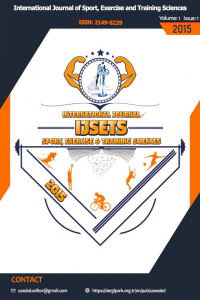Prepubertal tenisçilerde iki ayrı protokolde uygulanan ‘hit-turn tenis testinin’ kalp atım hızına, koşulan toplam mesafeye ve algılanan zorluk derecesine etkisinin incelenmesi
Amaç: Araştırmanın amacı, Hit-Turn Tenis testinde sabit duran toplara karşı yapılan vuruşlar ile bu testi modifiye ederek karşıdan atılan toplara karşı yapılan vuruşların kalp atım hızına, toplam koşulan mesafeye ve algılanan zorluk derecesine olan etkilerini incelemek olarak belirlenmiştir.Materyal ve Yöntem: Araştırmamıza dâhil edilen sporcuların yaşları 12.7±1.75 yıl, boy uzunlukları 155.2±3.1 cm, beden ağırlıkları 50.9±4.78 kg, antrenman yaşları 6.7±1.5 yıl ve haftada 5.7±0.4 saat antrenman yaptıkları tespit edilmiştir. Her bir sporcu hem Hit-Turn Tenis testini orijinalinde olduğu gibi sabit duran toplara karşı, hem de bu testi modifiye ederek karşıdan gelen toplara karşı vurarak gerçekleştirmişlerdir. Her iki test uygulanırken sporcuların toplam koştukları mesafeler, testler esnasındaki kalp atım hızları ve algıladıkları zorluk dereceleri kayıt edilmiştir. Her iki test esnasında toplanan verilerin tanımlayıcı istatistikleri hesaplandıktan sonra, testler arasındaki farklılıklar eşleştirilmiş iki grup arasındaki farklılıkları incelenmesine yönelik t-testi (Paired-Samples) ile analiz edilmiştir.Bulgular: Testler esnasında sporcular Hit-Turn Tenis testinde Modifiye Hit-Turn Testine oranla 124 m daha fazla mesafe kat etmişlerdir. Bu fark istatistiksel olarak anlamlı idi (t: 2,915; p<0.006). Bunun yanında kalp atım hızı değerleri her iki test esnasında birbirlerine benzer olduğu gözlenmiştir. Sporcuların her iki testi de algıladıkları zorluk derecelerine baktığımızda Modifiye Hit-Turn Testi sporcular tarafından daha zorlayıcı olarak bulunmuştur.Sonuçlar: Sonuç olarak, Modifiye Hit-Turn Tenis testinde sporcular filenin diğer tarafından gelen toplara vurmak için, sabit duran toplara yaptıkları vuruşlardan daha fazla efor harcadıkları düşünülmektedir.
Anahtar Kelimeler:
Tenis, Kalp Atım Hızı, Hit-Turn Tenis Testi, Aerobik Kapasitede
An examination of the effect of 'Hit-Turn Tennis Test' on two different protocols in pre-pubertal tennis players to heart rate, total distance runned and perceived difficulty
Aim: The aim of the research, Hit-Turnu Tennis test, fixed with punches against the top of this test modified by downloading thrown my heart made on kick against the top speed is defined as the total requirement distance and examine the impact of the perceived difficulty.Material and Methods: The ages of the athletes were included in our study 12.7±1.75 years, height of 155.2±3.1 cm, body weight 50.9±4.78 kg, training age was determined they did was 6.7±1.5 years and a week was 5.7±0.4 hours of training. Every athlete and tennis Hit-turn test against a stationary ball, as in the original, but they also perform this test by hitting the ball against oncoming traffic by modifying. Both tests from applying their athletes run totals, heart rate and difficulty during tests perceive degrees were recorded. After the data collected during both tests calculated descriptive statistics, the differences between the differences between the two groups paired t-test to examine test (paired-samples) were analyzed.Results: Hit Tennis athlete-turn test during the test, the modified test Hit-turn compared to 124 m They travel a greater distance. This difference was statistically significant (t:2.915; p<0.006). In addition, heart rate values are observed to be similar to each other when both tests. When we look at both testes of athletes perceived degree of difficulty Modified Hit-turn test it was found to be more compelling by athletes. Conclusion: As a result, the modified test Hit-Turn tennis athletes to hit the balls by other net, than they do to kick a stationary ball is believed to spend more effort.
Keywords:
Tennis, Heart rate, Hit-Turn Tennis Test, Aerobic Capacity,
___
- Borg, Gunnar. (1982). Psychophysical Basis of Perceived Exertion. Medicine and Science in Sports and Exercise. 14(5):377-381.
- Ferrauti A, Maier P, Weber K. (2002). Tennis training. Meyerand Meyer Verlag.
- Fernandez FJ, Mendez VA, Pluim B. (2006). Intensity of tennis match play. Brit J Sports Med, 40:387-91.
- Kovacs M. (2006) Hydration and temperature in tennis: A practical review. Journal of Sports Science and Medicine, 5:1-9.
- Fox EL, Bowers RW, Foss ML, (1993). Energy Sources, The Physiological Basis Of Physical Educatio buln and Athletics, WB. Saunders Company USA.
- Akşit, (2012). Tenis fizyolojisi ve performans, Derleme çalışaması. Turkiye Klinikleri J Sports Sci 2012;4(2):81-91
- Torres G, Cabello D, Carrasco L. (2004). Functional differences between tennis and badminton in young sportsmen. In: A Lees, J-F Kahn, IW Maynard (Eds.). Science and Racket Sports III. Routledge; Taylor & Francis Group.
- Bernardini M, De Vito G, Falvo Me. (1998).Cardiorespiratory adjustment in middle-level tennis players: are long term cardiovascular adjustments possible? In: T Reilly, M Hughes, A Lees (Eds.). Science and Racket Sports I. London: E & FN Spon.
- Ferrauti A, Kinner, V, Fernandez FJ. (2011). The Hit & Turn Tennis Test: An acoustically controlled endurance test for tennis players. J Sports Sci 29, 485–494, 2011.
- Lees A. (2003). Science and the major racket sports: a review. Journal of Sports Sciences, 21,707-732.
- ISSN: 2149-8229
- Başlangıç: 2015
- Yayıncı: İbrahim ERDEMİR
